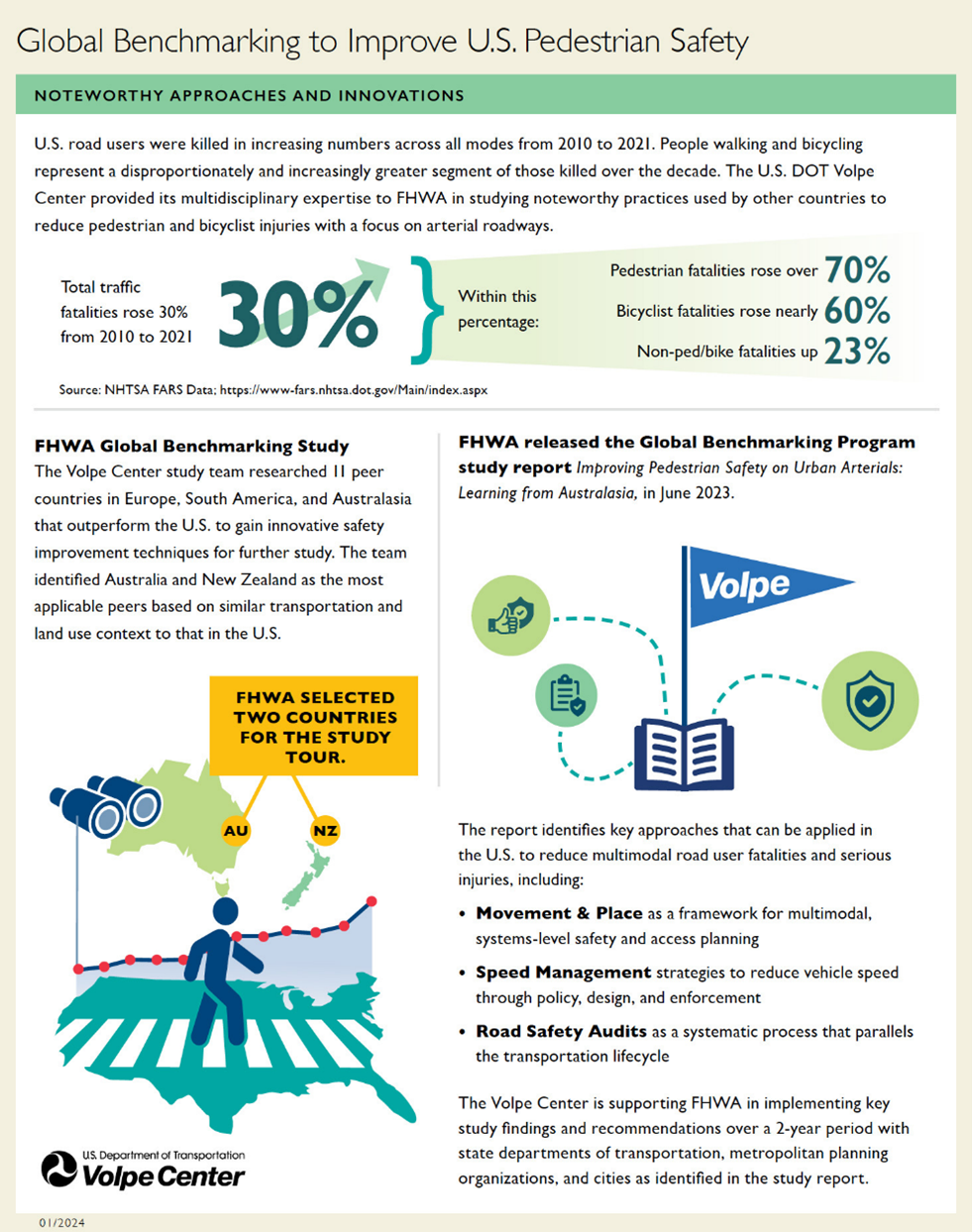Safeguarding Pedestrians through the Global Benchmarking Program

“We know roadway deaths are preventable because some places are doing a much better job at preventing them—both abroad and within certain U.S. communities. The U.S. Department of Transportation is committed to making real progress towards ending traffic fatalities, and we call on everyone to join us in this national effort that can only succeed when we work together,” stated U.S. Transportation Secretary Pete Buttigieg on the 2022 World Day of Remembrance for Road Traffic Victims.
According to NHTSA, total traffic fatalities in the U.S. rose 30 percent between 2010 and 2021—but these deaths were not distributed evenly between road users. While non-pedestrian/bicyclist fatalities were up 23 percent, bicyclist fatalities rose nearly 60 percent, and pedestrian fatalities increased over 70 percent. In 2021, NHTSA’s statistics indicate 60 percent of pedestrian fatalities occurred on principal and minor highways and roads.
To address this safety challenge, the FHWA Office of International Programs conducted a Global Benchmarking Study and drew upon the U.S. DOT Volpe Center’s multidisciplinary expertise to examine noteworthy approaches and innovations used by other countries to achieve reductions in pedestrian serious injuries and fatalities on arterial roadways. The goal for Phase 1 of the study was to identify proven practices, policies, and innovations that could be successfully applied in the United States to make existing and planned urban signalized arterials safer for pedestrians. Phase 2 was to supplement current FHWA activities to address pedestrian safety and complement additional work being conducted by other public and private organizations.
In summer 2020, during Phase 1 of the study, the U.S. DOT Volpe Center team performed a literature review and conducted interviews with more than 40 subject matter experts from 11 peer countries in Europe, South America, and Australasia (Australia, New Zealand, and surrounding islands). All 11 countries currently outperform the U.S. in pedestrian safety on urban, signalized arterials.
To identify which countries to best inform U.S. approaches among the 11 studied, the U.S. DOT Volpe Center study team applied six evaluation criteria:
- Policy (documented priorities, data-driven targets, funding protocols, and prioritization)
- Planning (practices to align project prioritization with need and policy)
- Design (engineering practices, signal design, geometric design)
- Technology (innovations that make solutions feasible, cheaper, and better)
- Data (information to measure baselines and targets, and to assess performance)
- Context (land use patterns and transportation network attributes)
In fall 2021, FHWA published its results, Benchmarking Program: Reducing Pedestrian Fatalities and Serious Injuries on Urban Signalized Arterials, detailing the performance of each of the 11 countries on the six key criteria. The study team concluded the countries with the best combination of innovative practices, demonstrated success in improving pedestrian safety over time, and contextual similarity were New Zealand and Australia. In fall 2021, the U.S. DOT Volpe Center also led a Global Benchmarking Program webinar, attended by more than 400 people, that presented the results of the desk review and previewed the planned study tour to Australia and New Zealand.
During the COVID-19 pandemic, the U.S. DOT Volpe Center team participated in four virtual peer exchanges with Australia and New Zealand to maintain progress while international travel was on hold. From September 12–16, 2022, the team conducted technical site visits and meetings in both countries, coordinating with three agencies representing three levels of government: the New Zealand Transport Agency (national); Auckland Transport, New Zealand (municipal); and Transport for New South Wales, Australia (state).
The final Global Benchmarking Program study report, Improving Pedestrian Safety on Urban Arterials: Learning from Australasia, was released in June 2023 by the FHWA Office of International Programs, completing the first phase of the project. The report:
- Identifies key innovations in policy, planning, and design that may be successfully applied in the United States to help reverse the current trend of increasing pedestrian and other vulnerable road user fatalities and serious injuries on arterial roadways;
- Focuses on policies that effectively prioritize, standardize, and fund engineering practices facilitating integration of new and emerging pedestrian safety strategies on urban signalized arterials; and,
- Identifies data-driven planning practices, and design standards and features, that effectively integrate pedestrian safety considerations into urban signalized arterial projects through a Safe System Approach, in conjunction with performance-based planning and programming that is coordinated with land use planning.
The U.S. DOT Volpe Center is currently supporting FHWA in undertaking Phase 2 of the study, which involves a two-year effort to implement key findings and recommendations resulting from the study. Implementation activities include conducting a four-part webinar series with the FHWA-funded Pedestrian and Bicyclist Information Center, a poster for use at multiple events, including the Transportation Research Board (TRB) Annual Meeting, a conference session at the October 2023 Association of Pedestrian and Bicycle Professionals, a moderated panel with Virginia DOT and California DOT and the FHWA Associate Administrator for Safety at the October 2023 AASHTO Safety Summit, and a workshop at the 2024 TRB Annual meeting. Additionally, the U.S. DOT Volpe Center team is collaborating with the FHWA Complete Streets Working Group to scope a future phase of work to implement strategies from the report in partnership with U.S. state departments of transportation, metropolitan planning organizations, and cities, as noted in the study report.
Sign up to learn more about the FHWA Community of Practice (CoP) on adapting research from this report into U.S. transportation practice. FHWA will support the CoP, develop resources for practitioners, and provide technical assistance to Tribes, State DOTs, MPOs, municipalities, transit agencies, and others working to advance the Safe System Approach in the U.S.

About the U.S. DOT Volpe Center
Celebrating more than 50 years of federal service to the nation, the U.S. DOT Volpe Center’s mission is to transform transportation for all.
